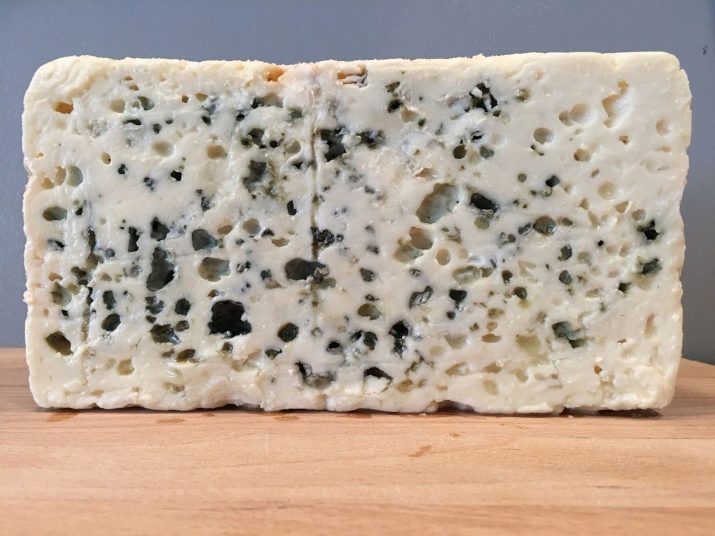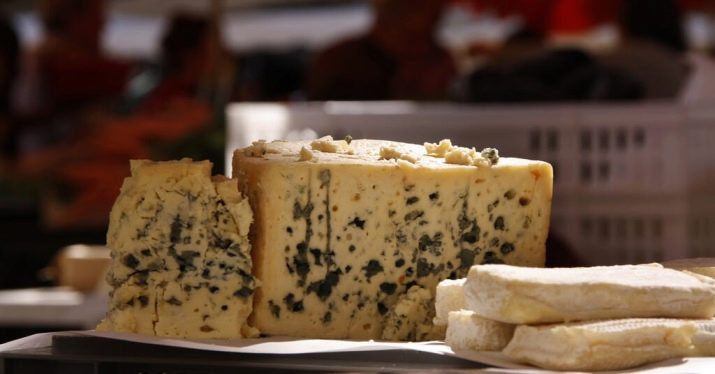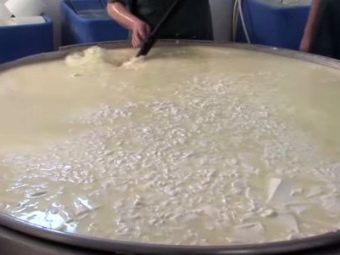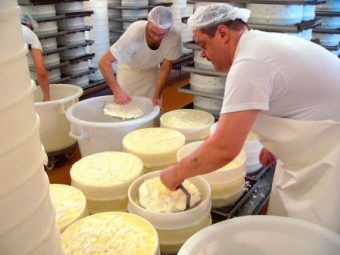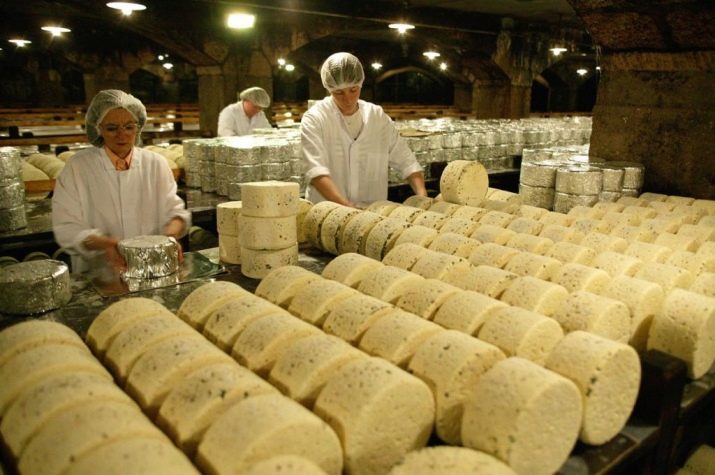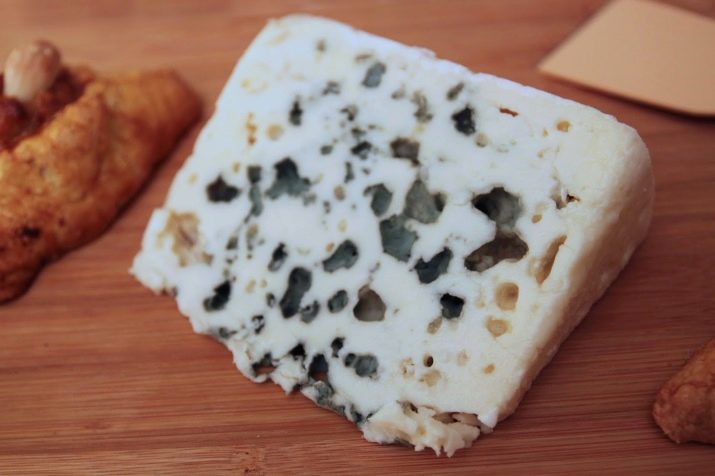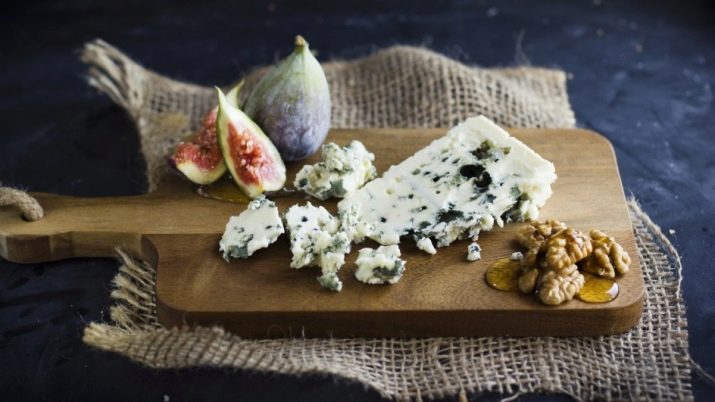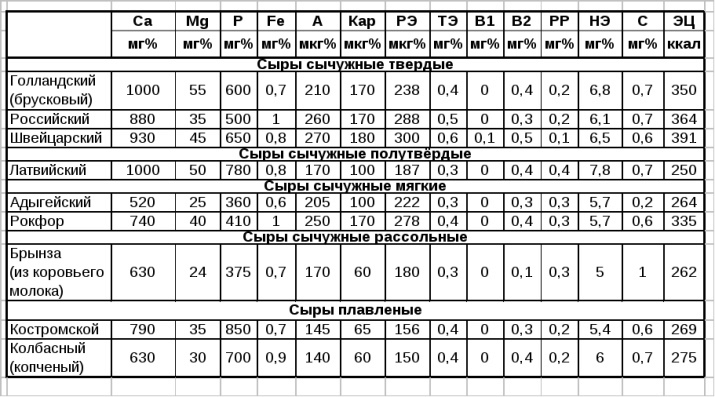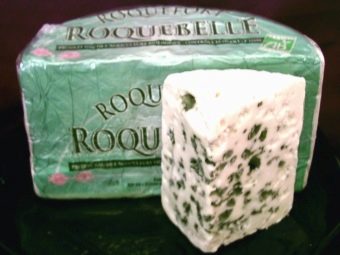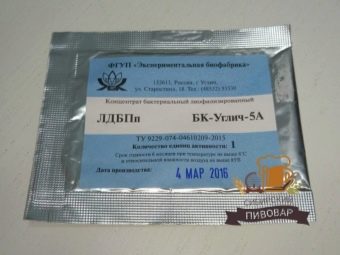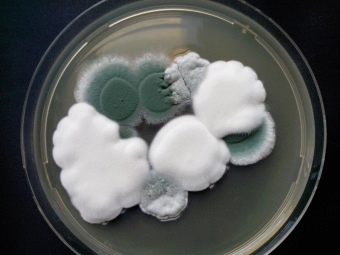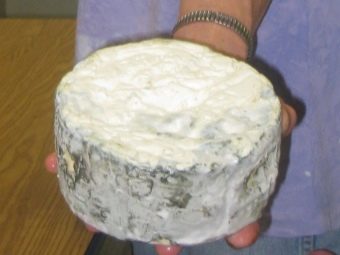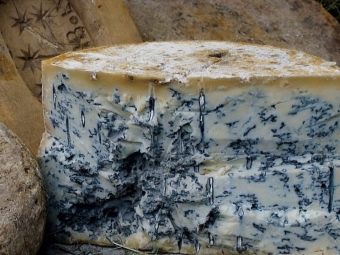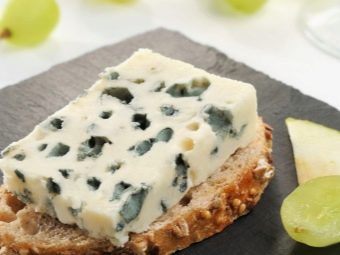Roquefort cheese: features, cooking at home and rules of use
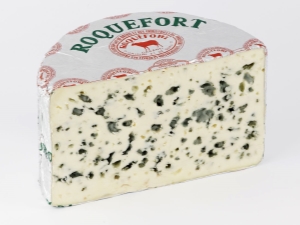
Roquefort - semi-soft cheese from France, covered with noble blue mold. Known as the "cheese of kings and the king of cheeses." It is made exclusively from high quality sheep milk. This variety is justifiably the title of elite cheese, which does not lose its significance and value to this day.
What is it and how did it appear?
A noble variety of blue cheese with mold is made in a place in the south of France - Rouergue province. The history of the appearance of this cheese is passed down from generation to generation and is presented to everyone as a kind of legend.
Early in the morning in the mountains of Combalou, near the village of Roquefort, the young shepherd, as always, herded sheep. A little later, he decided to have a bite taken with a piece of cheese and a slice of bread. The place for a meal was a cave, overgrown with greenery, mold, with high humidity. But he failed to bite off a piece - a beautiful woman passed by, distracted by whom he had forgotten about breakfast. A few weeks later, he happened to pass near that cave and he saw that a piece of cheese was covered with mold, which was distinguished by a blue color, and began to emit a strong smell. The shepherd was very hungry - he was not afraid to try the “overdue” breakfast. Surprisingly, he liked the cheese; he even admired such an unusual taste.
This is where the production of Roquefort cheese, originally intended for royal families, began. And the presence of mold varieties Penicilliumroqueforty and rich composition made this product also useful.
How do?
Blue cheese is made from sheep's milk. Pasteurized or, less commonly, raw. Before it collapses, it is heated to 25 degrees. After this, the ferment of lactic acid bacteria is added (up to 5%).
90 minutes are allotted for coagulation, with the temperature set at 30 degrees. After waiting for the formation of a clot, proceed to cutting into small pieces the size of 1x1 cm.
The next step will be continuous kneading for 45 minutes - all this is done to obtain the desired density. Next, prepare the table - cover his serpyanku. Now the curd mass can be laid out on the table top and allowed to drain off excess whey (usually 30 minutes is enough).
So, the cheese mass has cooled slightly, got rid of excess liquid. Now you can put it in the crusher, where it is grinding and mixing. After that, the mixture is laid out in forms.
An important point in the preparation becomes the distribution of the powder of the mold Penicilliumroqyeforty, without which the appearance of those very veins is impossible. Per 100 grams of cheese mixture will need 15 grams of fungal culture. To run the mold into the mass, the thickness of the layers should reach 2 cm - then about 4 layers will appear. Powder sprinkled evenly over the top of the cheese.
Completed forms with Roquefort, it is important to withstand a certain amount of time - 3 days. The temperature in the room should not be less than 20 degrees. The important point will be a regular and timely turning of the cheese. 1st day: turn over three times; 2nd and 3rd day - turn over every 12 hours.
As soon as the appearance of a pleasant sour-milk flavor is detected, it will become clear that the drying of the cheese is complete. On the 4th day, Roquefort is pulled out of the mold and begins to pickle - dry salt or specially prepared brine is suitable for this.
- To use the first method, you need to prepare sodium chloride in small crystals and begin to rub the head of the cheese, after which the product should be kept for about a week (the temperature of the place should be cool - no more than 10 degrees).
- The second method: prepare a 23 percent brine, where Roquefort is placed for 5 days in a room cooled to 15 degrees. After the time the head is washed with clean water and dried.
The final and most important stage is ripening. In order to develop that noblest mold, the cheese must be placed in an apparatus equipped with 3-millimeter needles. These needles can pierce one head about 30 times in all places.Such punctures are filled with air, which is a favorable environment for the development of valuable microorganisms.
After that, the cheese is placed on a shelf with a recess inside. As a place for maturation use the basement, where the humidity reaches 95% and the temperature does not exceed 5 degrees. Exclusively such an environment will allow Roquefort to acquire a blue mold, which will endow the dairy product with a spicy taste and a special aroma.
Two months are enough for ripening. Then the product is wrapped in foil and sent to a cold place. The unique piquant sharpness of Roquefort depends on the time of exposure (the sharpest one ripens in 9 months).
It is important not to forget to constantly wipe the cheese head and clean it from mucus.
Benefit and harm
Vitamins, minerals and amino acids necessary for a person have been given French cheese Some useful properties:
- anti-inflammatory function helps with arthritis and gout;
- protection against the formation of subcutaneous fat and the early appearance of wrinkles;
- fungal mold creates favorable conditions for the formation of beneficial microflora;
- gives a rapid saturation of the body - the feeling of hunger does not appear for a long time, the product helps in the fight against obesity;
- providing the necessary substances for the body (nutrients) for its proper functioning;
- the presence of easily digestible protein that can replace meat products;
- building function is responsible for strengthening bone and muscle tissue;
- the risk of diseases associated with the cardiovascular system is significantly reduced;
- reduced risk of heart attacks and strokes due to blue mold in cheese;
- responsible for strengthening the teeth and bones;
- high calcium content in the product will be a lifesaver for a woman in the menopausal period, safeguarding her against a disease such as osteoporosis;
- beneficial effects on the immune and nervous system;
- acceleration of healing of damaged skin;
- Amino acid from mold helps calcium get better and quicker in the body;
- due to the content of pantothenic acid, the adrenal glands can produce beneficial hormones - glucocorticoids;
- get rid of stress and insomnia will help the desired level of vitamin B5.
Roquefort cheese is on the list of the most useful cheese varieties. Experts have proved that the protein content in dairy product is almost equal to meat.
If you know the measure in the consumption of moldy cheese, then it can only bring benefit and aesthetic pleasure. Experts have established a daily rate that is safe for humans - 50 g of cheese. These indicators are valid for those who have no individual intolerance to the lactic acid product and penicillin substance. Having exceeded the daily dose, the fungal spores in the stomach will begin to worsen the intestinal microflora, which will lead to all known dysbacteriosis.
In the composition of the mold there are some microorganisms called Listerias. They are not terrible to a healthy organism, since the bacteria that have entered are quickly destroyed by immunity. In the risk group, pregnant women - listeriosis can sharply raise the temperature, lead to vomiting, sometimes even a feverish state is manifested. Such a disease has a negative effect on the fetus - miscarriage, premature birth or improper development of the embryo are possible.
Children with weakened immune systems are also susceptible to infection. It has a destructive effect on the nervous system, liver and lymph nodes. Symptoms are: runny nose, sore throat, swelling of lymph nodes, plaque on the tonsils. In this case, an urgent need to consult a doctor.
The conclusion of this is this: do not get too carried away with mold cheese, where an important component is penicillin fungi, which are considered antibiotics with a huge effect on the intestines. By sticking to a daily 50 g dose of Roquefort, you will save your body.
Composition and calorie
100 g of the product contains an average of 350 calories, of which - 20.5 g of protein, 27.5 fats and the complete absence of carbohydrates. BJU is represented by the percentage ratio - 24: 73: 0. Most of the composition is water - 40 g.
Chemical composition:
- vitamin C;
- sodium;
- sulfur;
- phosphorus;
- calcium;
- potassium;
- zinc;
- magnesium;
- niacin;
- beta carotene;
- alpha tocopherol;
Important components are the unsaturated fatty acids that the human body needs to a large extent - Omega-6, Omega-8 and ash.
- folic acid;
- iron;
- copper;
- biotin;
- valine;
- lysine;
- leucine;
- thiamine;
- arginine;
- calciferol;
- methionine;
- cobalamin;
- glycine.
Roquefort is a high-calorie product, most of which is fat. Therefore, you should be careful with overweight people, although a small piece per day will be quite safe. The diet can freely contain vegetable fats, replacing animals.
Selection and storage rules
True Roquefort is prepared according to a single recipe, which has not changed for many centuries. Cheese factories are located in the French village of Rouergue. On the market are products with 3 and 9-month maturity. This time is required for the development of noble mold. Due to the complex formulation and special conditions, the cost of the product is much higher. And the probability of meeting Monty on the shelves of stores is much lower.
Before you buy should pay attention to appearance. The cheese should be oily, white with blue patches. On a consistence - soft and gentle, does not break up. Remember, a large number of moldy veins appear due to long storage. This is a sign of no longer fresh, overexposed cheese and it is better to refuse it. As for the packaging, the real cheese depicts a red seal with the image of a sheep.
Natural sheep cheese with mold has a sharp, intense, sour flavor that distinguishes it from other cheeses. Blue cheese is a living product. Its taste and chemical qualities change rapidly. The best environment will be a wet place (95%) with a temperature not higher than 6 degrees - the refrigerator or cellar. Freezing will lead to the destruction of all nutritional properties. Warm temperatures develop a fungus, and cold temperatures, in turn, will make the cheese disintegrating into crumbs.
Keep Roquefort should not be together with other products, as it is possible creeping mold, which can harm. In this case, the cheese is better to wrap with foil or parchment. Since Roquefort quickly absorbs odors, do not put garlic, onions and fish products nearby. With proper storage, shelf life will reach 4 weeks.
Home Cooking Recipe
You will need:
- sheep milk - 8 l;
- mesophilic starter - 1 \ 8 teaspoon;
- Penicillium roqueforty mold - 1/8 tsp;
- 10 percent solution of calcium chloride - 1.7 ml;
- Liquid rennet - 2.4 ml;
- Salt - 2 tablespoons.
Such an amazing product can be prepared at home. The main thing is to choose the right and quality products and strictly follow the recipe.
Process description.
- Pasteurized milk. After that, it should be cooled to 32 degrees. We bring ferment. After the powder began to act, mix the mixture.
- We prepare two solutions in two containers: in one mix 50 ml of water with calcium chloride, in the second with rennet. Ready solutions are sent to the pan and mix. To form a clot, the mass must be brewed for about 40 minutes with a 30-degree temperature.
- Next, we check the clot: with a knife we make an incision, we lift this part and look - the edges should be smooth. If the mixture is filled with whey, then you can continue cooking. In another case, the curd mass should be given another 15 minutes.
- Cut a clot into 2-centimeter pieces, give time to settle and get rid of excess serum. Next, interfere with the resulting mass for about half an hour, while maintaining a temperature of at least 30 degrees.
- We got elastic grain. We wrap it in a drainage bag and hang for draining the liquid. Add a quarter of the mold. Cannot be compressed. The cheese should be spongy in texture. We shift the grain of cheese in the form, adding mold to each layer. The tip remains clean.
- Cover the cheese and leave for a while to be pressed under the load. For one head it will take 30 minutes, for two - an hour, three - two hours.
- We start salting. There is 1 g of salt per 100 g of product. We distribute the required amount of salt over the entire surface of the cheese and put it in a fridge in a mold for a day.
- We spread the dairy product out of shape and move it into a 5-liter container - this is where Roquefort will ripen within 5 days in a 10-degree setting.
- It is important to follow the rules of care: constantly turn over and wipe the cheese heads from excess liquid.
- To fill the cheese with mold you need to make a through puncture. The air will fill these holes, and that blue mold will grow in them.
- After a couple of weeks you will see blue streaks. So the process is going well. It will take more than 2 months to ripen Roquefort with preservation of temperature 10-13 ° C.
How and with what is served?
Before use, take the cheese out of the refrigerator and wait until it reaches room temperature. That is how blue cheese will show you all the richness of taste with sharp creamy notes. French Roquefort is suitable for snacks and desserts. Gourmets prefer to use cheese with white bread, for example, with a baguette. Served surrounded by grapes, apples and pears. It is used to make pasta, pizza, salads, sauces and cream soup. The French wash down the cheese with dry wines of white varieties, as well as dessert and fortified.
How to make Roquefort cheese at home, see the following video.

